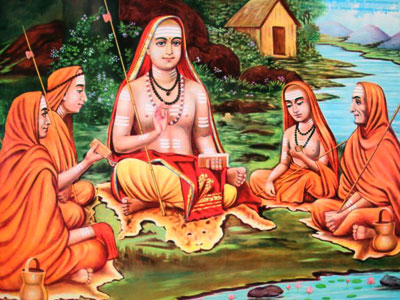श्रुति स्मृति पुराणानाम् आलयम् करुणालयम् ।
नमामि भगवत्पादम् शंकरम् लोक शंकरम् ॥
The common Indian word for cultural activities as a whole is termed as Achara. Acharya means a person who adds, deletes or modifies suitable items to the cultural activity system and performs the achara or persuades his followers for the benefit of the society. Here in this article, one of the prominent persons is Shree Adi Shankaracharya, for our benefits. He is not the initial one in his line, but we treat him as prominent in his lineage. He propagated the forgotten Advaitha Philosophy of India. His Guru or teacher was Shree Govinda Bhagavad Pada Acharya. The previous known Guru or teacher of Shree Govinda Bhagavad Pada Acharya is Shree Gauda Padacharya. Shree Adi Shankaracharya is a great social reformer, writer in Sanskrit, founder of the great Advaitha peetha Mathas at four places of India, i.e., at Puri of Odisha, Sringeri of Karnataka, Dwaraka of Gujarat and Badarika of Uttaranchal, which are still functioning.

In Kerala, near Kalady, on the bank of a local river, one Shankara Ashram has been renovated by the Holy Swamiji of Sringeri in the place exactly where Adi Shankaracharya has born in 788 AD. In token of honourable memory of this great saint, one Stupa is also built near the same place at Kalady. The birth of Adi Shankaracharya is a blessing of God. As a result of many years’ prayers and penance performed by Shri Shivaguru and Aryamba, this lone child, Adi Shankara was offered as a boon to them. The customary Annaprasana, and later early Vidyarambha were performed by his parents in Kalady. His father Shivaguru was a great devotee of God and simple in living. He wished to perform the sacred thread ceremony to the child as his family custom and system at an early date. So he completed it before date.
Young Shankara finished his primary education in the same village, joining other children of his locality. He was showing higher abilities than his colleagues. Even though young, he wanted to see God as an innocent boy. By his curiosity, he somehow understood that in the life of a sanyasi, God comes and resides in his heart. He preferred to become a sansyasi. Meanwhile, his father expired.
One day while his mother was washing clothes, young Shankara was taking bath in the nearby river. A crocodile suddenly captured his leg and this young child screamed aloud, ‘O mother, crocodile may eat me, permit my last wish to become a sanyasi now’. His mother wanted to live him happily. His mother immediately agreed and wished him to become a great man in future. It was a plan of nature itself and the crocodile immediately left and disappeared into the river water. Shankara was very happy and finished all his local education as customary to learn some vedic chantings. He took leave of his mother and started for higher learning in search of a suitable teacher, the learned Guru.
At Narmada river bank, he met Shri Govinda Bhagavad Pada acharya and became his disciple. He learned all four branches of veda, upaveda and six vedangas, Finally, he reached Vedanthas and mastered every required Sanskrit subjects. The name of the teacher of Shree Govinda Bhagavad Pada acharya is Shree Goudapada acharya. Shree Gouda pada acharya had instructed Govinda Bhagavad pada to write commentaries to three items, in sanskrit. Commentary in Sanskrit is called Bhashya. This work was pending since the place suitable for executing the same work required travelling to Varanasi and halting there in the old age. Shankara, as he was young, accepted the challenge and completed the task. This work is famous as prasthana thraya bhashya.
It contains commentaries on three items. First one is Bhagavad Geetha. Second one is Brahma sutra and third one is Upanishad books. Out of 108 Upanishad books, 18 became very famous. In addition to finishing writing of bhashyas, young Shankara has also written elaborate explanations to the 555 Gouda pada Karikas also. Karikas are more or less like proverbs in Sanskrit prose. Shankara submitted all works to his Guru, Shree Govinda bhagavad pada and informed his desire of becoming a sanyasi. His Guru administered the same and thereafter, Shankara has been known as Shankara acharya.
Shankara started the life of a sanyasi. He used to teach young brahmacharis for his livelihood. He was leading a pious life. He wanted to see God. One fine morning, when he was returning from the river Ganga after taking bath, four dogs with fowl smell surrounding a man was found on the way. The matured Shankaracharya ordered him to go aside, leaving the way to his movements with maximum path clearance. The other man, in between the fowl smelling dogs, immediately counter questioned, ‘Are you ordering me or the God residing in my heart?’ On hearing the reply of that man, Shankaracharya immediately understood that this is not a man but God himself appeared as a man in front of him just to test his knowledge. Shankaracharya immediately fell up on his feet, sought his pardon. The other man blessed Shankaracharya, and disappeared with the four dogs. Adi Shankaracharya understood the four dogs that disappeared are nothing but the four branches of vedas.
Shankaracharya found many evil practices in the society. He decided never to use weapons. He started to travel in India. He used to teach and distributed the books he had written to his disciples for learning and preserving. He renovated twelve Shiva temples, called Dwadasha Jyothirlingas. He renovated nine Devi temples, out of which three temples became more famous.
One day, Goddess appeared before Adi Shankaracharya and he requested her to follow him. Goddess agreed under the condition that he will always proceed without turning back. So Shankaracharya moved from the north Kashmir to south steadily and frequently hearing the anklets’ tinkling sound of the following Goddess. Upon reaching Sringeri Thunga river bank and due to the soft mud, he could not hear the anklets’ sound. In order to confirm the follower Goddess, he turned back. Goddess immediately reminded the agreement and wanted to sit in Sringeri. Adi Shankaracharya conducted pooja to the Goddess at Sringeri and requested to follow him again with an excuse. Goddess agreed under the same terms and conditions. So Shankaracharya moved from north Sringeri to south steadily and frequently hearing the anklets’ tinkling sound of the following Goddess. He reached Kollur and moved on the side of paddy fields. Due to the mud again, he could not hear the anklets’ sound. In order to confirm the follower Goddess, he turned back. Goddess immediately reminded the agreement and wanted to sit in Kollur. Adi Shankaracharya conducted pooja to the Goddess at Kollur and requested to follow him again with another excuse. Goddess agreed under the same terms and conditions. So Shankaracharya moved from north Kollur to south steadily and frequently hearing the anklets’ tinkling sound of the following Goddess. He reached Chottanikkara in Kerala and while passing by the side of a water tank, he could not hear the anklets’ sound again. In order to confirm the follower Goddess, he turned back. As usual, the Goddess immediately reminded the agreement and wanted to sit in Chottanikkara. Adi Shankaracharya conducted pooja to the Goddess at Chottanikkara and requested to bless all people who devout with reverence. The Goddess agreed. He was happy to achieve three seats in three temples for the Goddess.
He further travelled with his Shreechakra and reached Thirupathi. Shree Shankaracharya has written commentaries to the verses of Lalitha sahasranama, being the worshipper of Shreechakra. ‘Deyam Deena janaya cha vittam’ means money is to be given to the poor people. Shree Shankaracharya has written these lines in his creation ‘Bhaja Govindam’ stotram. It is believed that he has laid his Shreechakra at Thirupathi temple before leaving to Badarika ashram and from that day onwards, money offerings started coming into Thirupathi (Click here to read more about Shree Chakra). Shree Shankaracharya has written commentaries to the verses of Vishnu sahasranama also.
Shree Shankaracharya has established one Matha at Badrika and named it as Jyothirmatha. The Sanskrit creations were completed there and he desired to have a disciple for this Matha. Again, Shree Shankaracharya conducted journey with a decision to establish three more Mathas at different places of India. He wished to post three disciples there. During this journey, he got four disciples and posted them at the four Mathas. Thus, at Puri he posted Padmapadacharya, Sureshwaracharya at Sringeri and Hastamalakacharya at Dwaraka. Thotakacharya, the fourth disciple followed Adi Shankaracharya to Badarika and was posted to that Matha later.
The four branches of veda were to be preserved in four places of India for Indian’s future, Shree Shankaracharya determined, for a happy and peaceful life.
There are many achievements during the living period of Shree Shankaracharya in his short span of 32 years of life. A few more articles in this website will be published in future. Readers are kindly requested to stay tuned and browse this site frequently.

0 Comments
4 Pingbacks